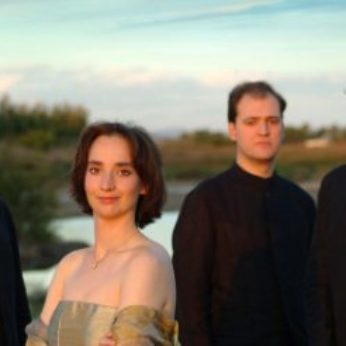Composer: Franz Schubert (b. 1797 - d. 1828)
Performance date: 29/06/2013
Venue: St. Brendan’s Church
Composition Year: 1813
Duration: 00:21:29
Recording Engineer: Damian Chennells, RTÉ lyric fm
Instrumentation: 2vn, va, vc
Instrumentation Category:String Quartet
Artists:
Cuarteto Casals (Abel Tomás Realp, Vera Martinez Mehner [violins], Jonathan Brown [viola], Arnau Tomás Realp [cello]) -
[quartet]

This quartet dates from Schubert’s youth,
just after he had left the Imperial Seminary in 1813 where he had been studying
as a boarder for five years. He had got a scholarship there as a result of
being a member of the Court Chapel Choir, but his voice had broken the previous
year. He was offered a renewal of his scholarship only if he gave up music. By
this stage Schubert was already a prolific composer and there was no question
of him giving up composing in order to improve his other subjects. So the
sixteen-year-old Schubert returned to his father’s house and began studies at a
teacher training school – his father was also a teacher.
The household was a musical one and there
was a family string quartet involving his father and his brothers Ignaz and
Ferdinand. The E flat Quartet was already his eighth quartet, which gives some
idea of his speed of composition. Clearly the amateur in-house quartet made it
possible for him to try out some of his music, but the time was drawing near
when he would need professional musicians to interpret his ideas. All four
movements are in E flat, which may explain the extreme tempo contrast between the
two middle movements from Prestissimo to Adagio – without a contrast in key he
needed a contrast in dynamics to establish their individuality. The opening
movement is a gentle and lyrical Allegro, with long, unhurried melodies that
effortlessly support the structure. The development is short but the youthful
composer is already mastering the intricacies of a concise and effective sonata
form. The rough humour of the brief but hectic Scherzo owes much to both
Beethoven and Haydn, while the tranquil Adagio maintains a quiet serenity over
its compact, sonata-form span. The finale is distinguished by a totally
irresistible second subject following after a jaunty first subject. This is
another crisp sonata-form movement with a powerful surging development. Schubert’s
biographer, Brian Newbould, considers it his most successful pre-1820 quartet
for its structural confidence, melodic invention and succinct expression.
Copyright © 2024 West Cork Music. All rights reserved.
Designed and developed by Matrix Internet